A few people might think that cleaning or fixing your pool means it has to be drained. One slip and your fibreglass pool could end up popping right out of the ground, costing thousands to repair or reinstall.
Many homeowners don't realise that draining a fibreglass pool isn't as simple as just pulling the plug. Get it wrong, and you risk major cracks, warped walls, or a pool shell that lifts like a boat after rain.
But there's good news: draining your pool is hardly ever needed if you know what you're doing and if you have a pool professional to consult with to do it.
In this article, you'll learn when, why, and how professionals drain a fibreglass pool safely. This is only to inform you of the steps and cases to drain the pool, but please don't do it by yourself.
Highlights
- Draining a fibreglass pool is risky and should only be done by trained professionals, not for everyday cleaning tasks.
- All in-ground pools, including concrete and vinyl-lined, can float, shift, or pop out if groundwater is high and the pool is empty.
- Draining should be a last resort; most routine cleaning, chemical fixes, and even algae problems can be handled without emptying your pool.
- When draining is needed, like for major repairs or severe contamination, always have a professional check the groundwater and brace the pool shell before starting.
- If draining is done, it must be slow and careful, with repairs and refilling starting immediately to avoid potential shell damage or movement.
- Always follow Australian Standards, keep the right support in place, and contact a pool expert to avoid costly, dangerous mistakes.
The Risks of Draining a Fibreglass Pool
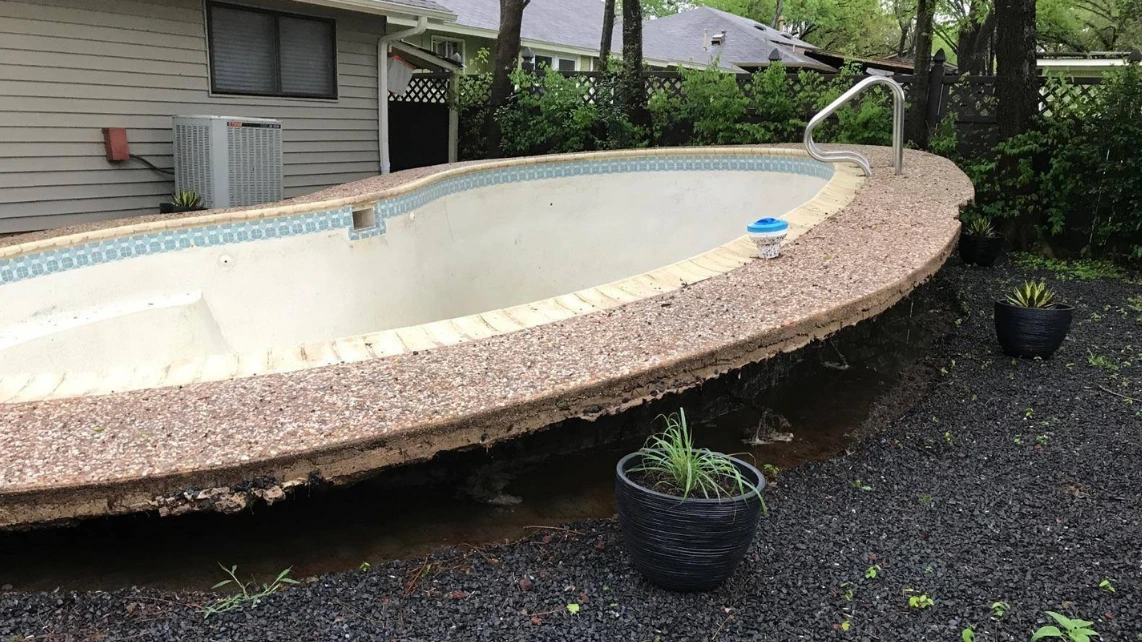 An image of a fibreglass pool that has popped out of the ground due to groundwater and saturated soil. Source: reddit.com
An image of a fibreglass pool that has popped out of the ground due to groundwater and saturated soil. Source: reddit.com
We know you've heard it already: fibreglass pools pop out of the ground after a heavy rain or when a pool owner drains it.
To be honest, draining a fibreglass pool is a big deal. It's not something you should do every time you want to clean the pool, even if it is very green due to algae, has a thick layer of dirt at the bottom, or maybe you just want to change the pool water because you think it needs to be.
In fact, it's a job best left to trained experts, as there are some real dangers if you get it wrong, and many people don't realise just how risky draining a fibreglass pool can be until it's too late.
But take note of this: all types of in-ground pools can float or shift if installed in a high water table, not just fibreglass pools. This risk comes from a science principle called buoyancy, and it affects fibreglass, vinyl-lined, and even heavy concrete pools, although how it happens can look a little different for each type.
In a fibreglass pool's situation, when you take the water out of it, you remove the main thing holding the pool shell in place. The weight of the water pushes the pool shell down, helping it stay still and strong inside the ground.
So if you drain that water away, there's nothing fighting back against the pressure from the soil around the shell. If the ground is wet or there's a high water table, the empty shell can actually lift up, twist, or even 'pop' right out of the ground. It's a problem nobody wants.
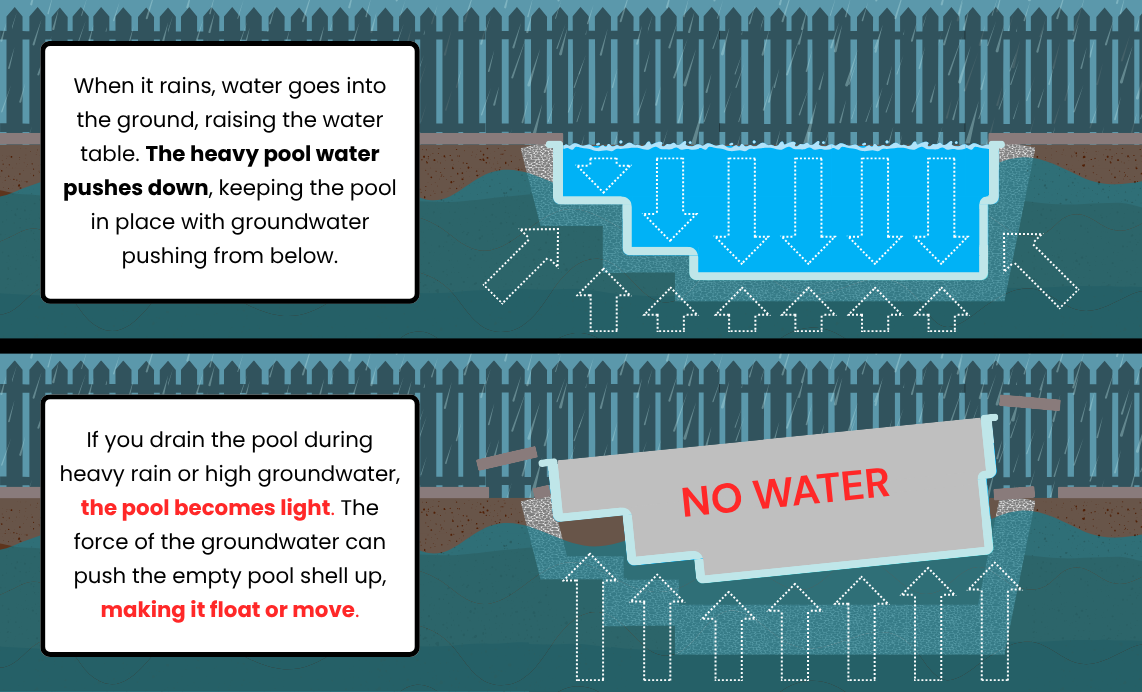
There's a video online that shows exactly what can go wrong. A family's pool suddenly pops out of the ground. It's a real-life example of why draining a pool is a job for the pros, not a DIY task.
We've been installing fibreglass pools for many years, and in all that time, none of the pools we put in have ever popped out of the ground.
It's not that we're lucky. We just follow the standard procedure when installing a fibreglass pool, and we partner with Harvest Pools, which creates high-quality fibreglass pools for Mackay folks.
When you stick to proper installation steps and follow Australian Standards, your pool stays safe and secure, even in tricky conditions. Careful planning, the right base material, and good maintenance keep everything right so you can enjoy your pool without worry.
When to Drain Your Fibreglass Pool
Some people think draining the pool is the best way to clean it, but that's not true for fibreglass. Most cleaning, fixing, and algae treatments can be done with water in the pool.
If you drain it for every problem, you risk cracks, bulging walls, or even a pool shell that needs replacing. That's why we listed some of the problems that might need draining your fibreglass pool and those that don't.
When Draining Is Needed
Sometimes, there's no way around it. Your fibreglass pool needs to be drained. These aren't your everyday pool problems. They are situations where emptying the pool is the only safe or practical choice, and waiting could make things worse.
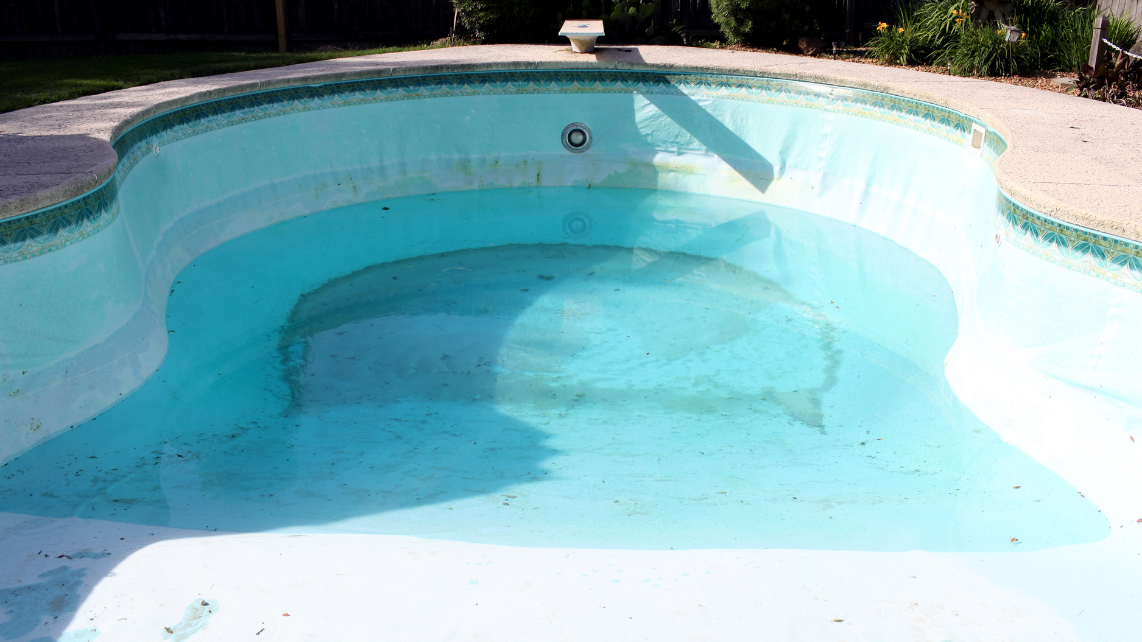
- Major repairs. If your pool has cracks, big leaks, or structural damage, draining is often the only way pros can reach the problem for a proper fix. Trying to patch or work underwater just doesn't get the job done for large repairs, so taking all the water out gives the repair team clear, safe access.
- Resurfacing or repainting. You can't refinish, paint, or resurface a fibreglass shell unless it's empty. These projects need a dry, clean base so that new surfaces bond properly, and so no new damage or bubbles appear later.
- Severe chemical or pollution event. Sometimes, after a bad chemical spill, sewage leak, or heavy flooding, pool water becomes unsafe. If chemicals are way off, or dirty water gets in that can't be fixed with normal treatments, draining is the only way to start fresh with clean, safe water.
- Deep acid washing. If tough stains, algae, or calcium just won't budge, a deep acid wash may be needed. This process relies on draining all the water, then using a special acid solution to scrub the inside surface. Only professionals should do this, as using acid can damage your pool if done wrong, and you must follow local safety and disposal rules.
- Persistent staining. If you've tried cleaning but certain stains stick around, draining might be needed to get at those marks. With the water gone, pros can use special cleaners or treatments to remove the stubborn spots completely.
- Preparing for major renovations. Big changes outside or inside the pool, like replacing pipes, adding new lights, or ripping up old paving or decking, sometimes mean the pool needs to be empty. This keeps your pool safe from damage and lets professionals work without causing new leaks or cracks.
- Unfixable water quality. Sometimes, pool water gets so full of minerals, salts, or dissolved solids that normal cleaning and chemicals won't help. If the water always seems cloudy or smelly, or pools of algae keep coming back, a total drain and refill is the only way to get things back to normal.
- Heavy debris after disasters. If your pool fills with ash, sticks, or rubbish after a bushfire, big storm, or disaster, cleaning with the water still in isn't possible. There's just too much mess to vacuum or scoop out, so draining is safer and faster.
- Professional winterisation. While rare in most of Australia, some experts may recommend draining a pool as part of special winter shutdown steps, usually only under their guidance and in specific cases.
Each of these reasons is serious, and every time you even think about draining your pool, it's safest to call in a pool professional. Doing so keeps you, your pool, and your backyard safe so you can get back to swimming, not worrying.
When Draining Is NOT Needed
For most pool problems, you don't need to drain your fibreglass pool. Many common issues can be solved by yourself and your equipment while the pool still has water.
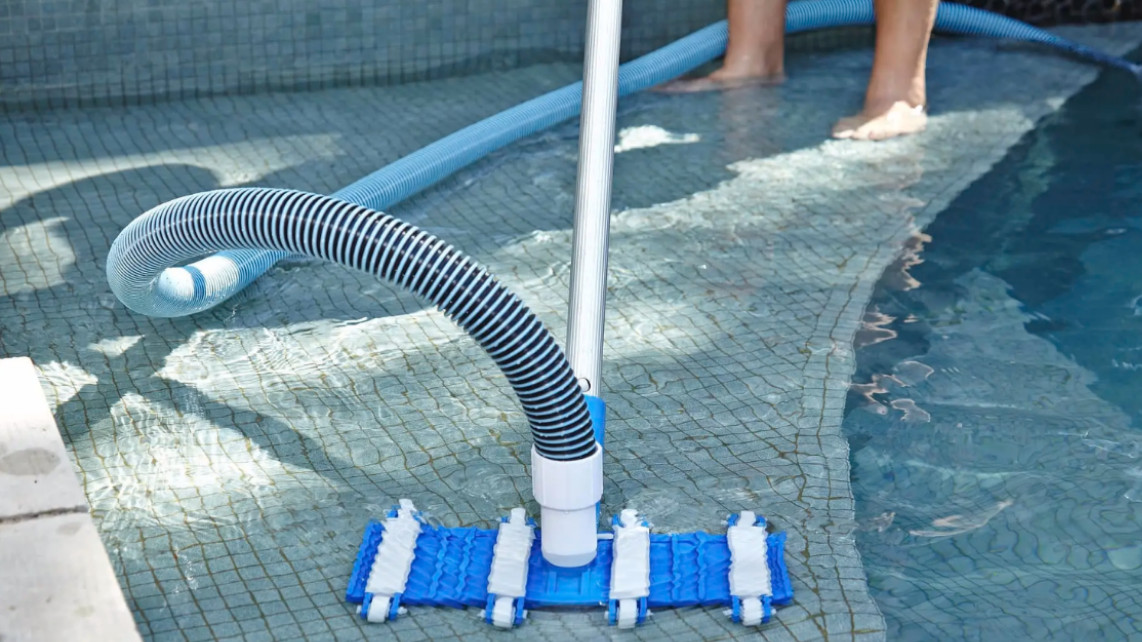
- Normal cleaning and debris removal. Leaves, sand, and bugs can be scooped out easily with skimming nets or removed using pool vacuums and robotic cleaners.
- Algae treatment. Most algae problems, including green water, can be treated with chemicals and proper brushing. If you keep up with the right balancers, algae can be cleared without taking the water out.
- Water clarity or chemical fixes. If your pool water looks cloudy or the chemistry is off, these issues almost always improve by adjusting chemicals, running the filters longer, and cleaning the pool.
- Patch repairs. Small chips or scratches in the fibreglass shell can often be repaired underwater by skilled technicians.
- General maintenance. Routine jobs like cleaning filters, balancing chemicals, backwashing, or even swapping out old equipment can all be done without draining. Keeping your pool water in place during maintenance helps protect the pool's structure.
- Dirty water. Sometimes pools are neglected or change hands with murky water. Even then, most pools can be recovered by cleaning and chemical treatment without draining.
- Buying, selling, or moving house. If your pool is part of a property sale or new ownership, draining is not required. The pool can stay full and healthy during the transfer, keeping it ready for use.
- Foreclosed or abandoned pools. Even pools that have been left unused or poorly maintained can often be saved with cleaning and balanced chemicals. General maintenance can be done first to make it look brand new once more.
- DIY attempts. Draining your fibreglass pool yourself is a big risk. Without the right knowledge and equipment, you could damage the shell, void your warranty, or face expensive repairs. Always call a professional instead.
How to Drain a Fibreglass Pool Safely
Draining a fibreglass pool must be done the right way if it is really needed. If you rush it or skip steps, you can cause serious damage to your pool shell and even to your backyard.
Here's a simple guide to each stage, so you can see why each part matters and what has to happen for a safe pool drain.
Disclaimer: As cliché as it may sound, please let the professionals do this job, or get help when you want to learn when and how to do this.
1. Check the Weather and Groundwater
First, check the weather forecast. Pick a few days in a row when it won't rain, and make sure the temperature isn't too high or too low. Ideally, the best time to drain is during dry weather, when the soil is firm and water levels underground are low.
Avoid draining during or just after storms, heavy rain, or even after a long period of irrigation in your garden.
Let's say the weather is dry. Before even turning on a pump, always look at what's happening around your pool as well. If it's been raining hard, the ground under your pool or the water table may be high.
A fibreglass pool should always have both a hydrostatic valve and a standpipe installed. These two features work together to help manage groundwater pressure, and the standpipe can help you check and drain the groundwater using a submersible pump.
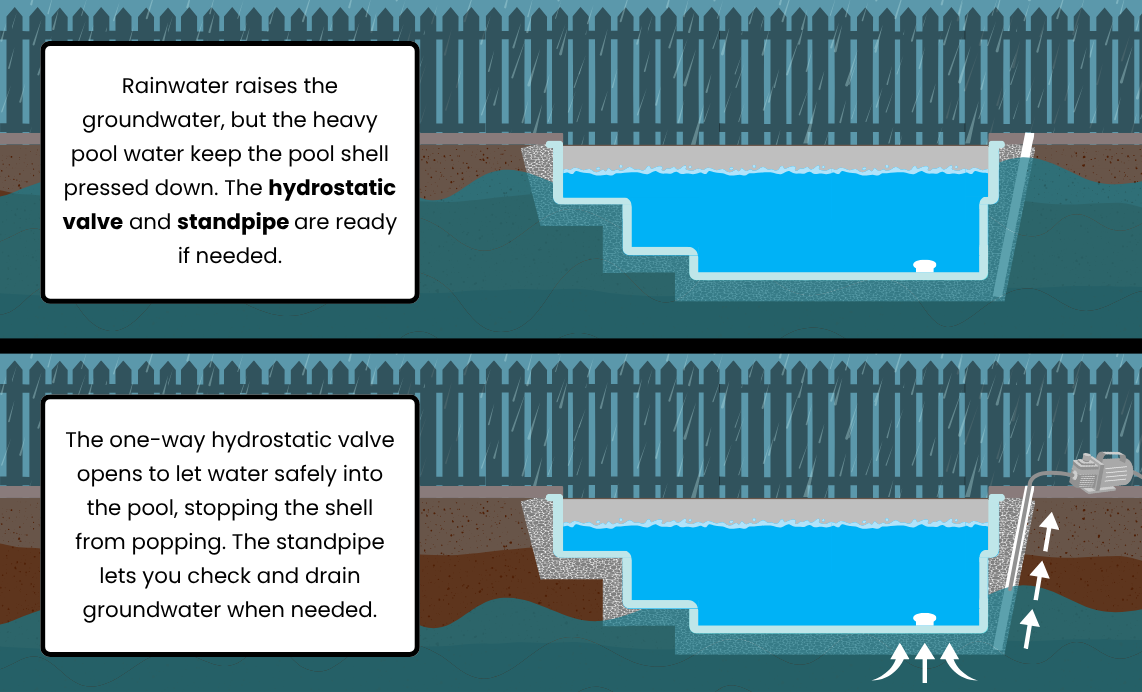
If your pool experts check the groundwater and it's high, they will lower a submersible pump down the standpipe until it sits in the bottom to collect groundwater while the discharge hose is placed on a disposal point (like a stormwater outlet or suitable drain, in line with your local council rules).
2. Brace and Protect the Pool
Once they've checked the weather and groundwater, it's time to think about the pool bracing. If the sides aren't supported, they can bow in or even crack under the pressure from the ground and backfill outside.
Experts use sturdy wooden or metal braces placed across the pool, usually about halfway down the walls. These braces act like extra muscles, giving the shell extra strength while it's empty.
Sometimes, special straps are used that stretch from one side of the pool to the other, just above where the water line will sit when the pool is refilled. The braces help stop the walls from moving inwards as water is pumped out.
After placing these and before draining, you should also check for loose soil or gaps around the outside of the pool. If there's any chance soil could move or slip into the gap, it needs to be packed or supported before draining starts.
You must also be careful near the pool's step area and corners. These are places where the shell can be weaker. A pool expert will always make sure every part has a backup holding it in place.
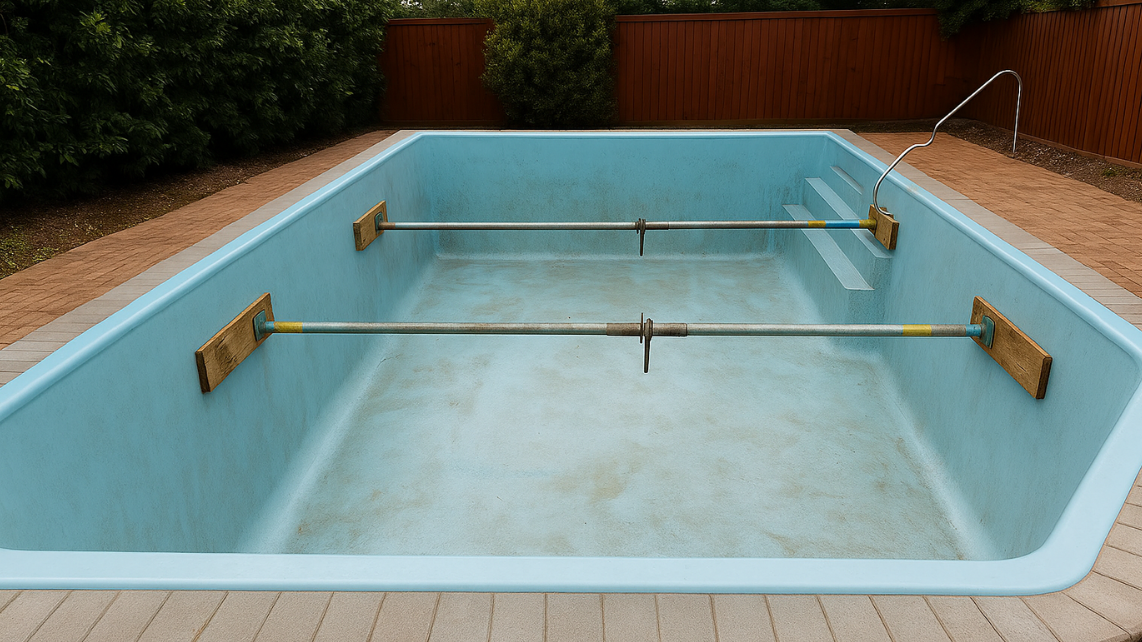
3. Drain Slowly and Evenly
To drain the pool, professionals use a heavy-duty submersible pump, which is placed at the pool's lowest point. They can use the one they have for the groundwater, or it could be different. They should also choose a proper disposal point for this part.
This kind of pump moves water steadily out of the pool, and its size is chosen carefully: too fast, and you risk sudden shifts in pressure that can harm the pool shell. Too slow, and the job drags on, making it less safe if the weather changes.
A pool professional will watch the whole time, checking the shell for any flexing, cracking, or sudden movement. Sometimes, draining is paused partway if it looks like the shell is under strain.
It's also smart to drain the water out in stages, a bit at a time, instead of all at once. This gives the fibreglass more time to adjust to changes in pressure.
As the pool empties, small puddles or pools of water are left behind and are removed carefully. The pump's intake should never sit directly on the pool floor. If it does, it can suck up bits of debris or even damage the shell itself. Instead, use a mat or place the pump on a small tile.
Throughout the whole draining, keep checking outside the pool. Look for gaps forming around the shell, changes in the soil, or any wet spots. If the pool seems to rise or shift, stop draining immediately.
4. Start Repairs or Cleaning Straight Away
Once your pool is empty, there's no time to waste. You and your pool expert need to start any repairs or cleaning right away.
If you're resurfacing, repainting, or fixing cracks, have the materials and tools ready before draining. For cleaning, be careful what products to use. Stick to those that are safe for fibreglass shells and won't scratch or weaken the surface.
The sooner the job gets done, the sooner water goes back into the pool, and the less risk you have of any damage or movement. This is one reason why a good pool expert will never agree to drain a pool unless a full plan is in place to fill it up again soon.
5. Refill the Pool
As soon as the repairs or cleaning are finished, it's time to start putting water back in. Always use clean, fresh water. But if you're not sure if your mains supply is safe, ask your installer or even use delivered water in some cases.
While the pool is refilling, keep an eye out for any shifting or settling in the shell. The water's weight will help press the pool back into the ground evenly, restoring that balance and stability.
Fill the pool steadily, not too fast and not too slow, so that the pressure builds up evenly on all the walls.
Once full, test the water for the right balance of chemicals before anyone goes swimming. You might need to adjust things like pH, chlorine, or calcium hardness to make the water safe and comfortable.
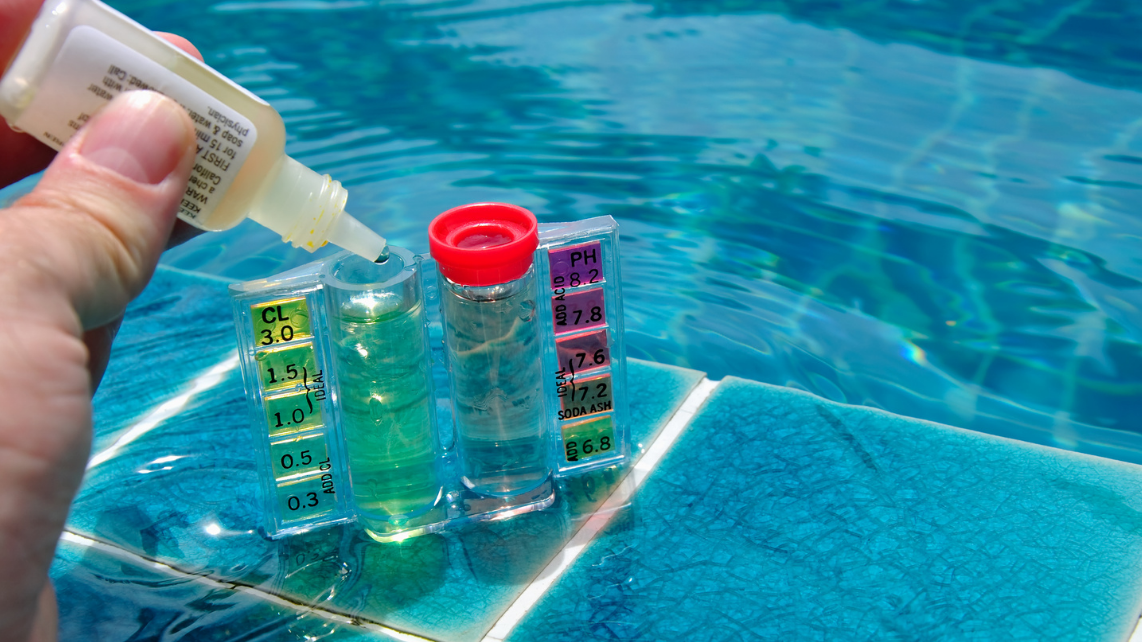
Final Thoughts
Draining a fibreglass pool is a big decision. It's not done often and for any random reason. With the right planning and help from a pool professional, you can keep not only your pool strong, but also your backyard's safety as it might be affected by the pool's popping out.
Don't forget this final tip: always check the groundwater, not just when draining. Do this after a heavy rain or storm and drain it with your submersible pump. You might not know your soil's water table has been deceiving you the whole time.
If you ever need help with your fibreglass pool maintenance or project, just reach out to us. We are licensed installers with years of experience installing, cleaning, and repairing fibreglass pools in Mackay, and we're happy to chat or give you a quote.
And if you're still thinking about which fibreglass pool to choose, check out the fibreglass pool designs our partner offers. There's always something for every backyard and budget.
